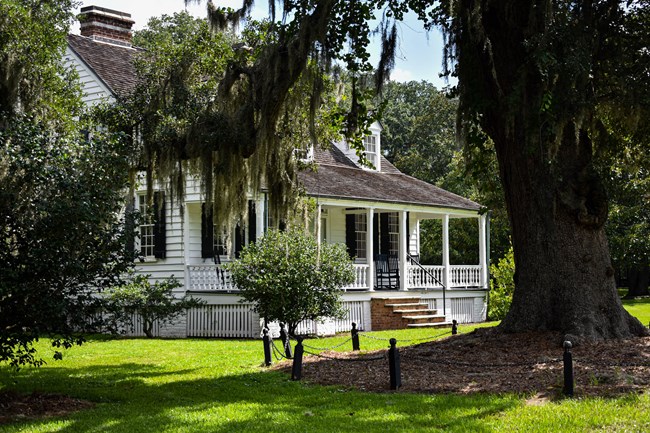
NPS Photo Archaeological ResourcesCharles Pinckney's father purchased Snee Farm in 1754 and the land remained in the Pinckney family as a Lowcountry plantation until the younger Pinckney sold the property in 1817. No Pinckney structures survive at Snee Farm today. Family papers that may have provided insight into the family's use of the property were likely destroyed in a Charleston fire in 1861. Most of what is known about the family's years at Snee Farm has come from archaeological investigations. Besides providing insight into how life at the plantation shaped Charles's views towards public service and politics, archaeology also offers an opportunity to understand the lives of Snee Farm's enslaved population. Professional excavations of the park's archaeological resources began in 1987 and uncovered remains of several Pinckney-era outbuildings including the kitchen site, well, and portions of the slave community at the plantation. These discoveries offer the opportunity for more accurate interpretation of South Carolina Lowcountry during the 18th and 19th centuries and allow researchers to explore the lives of all the property's former inhabitants. 
NPS Photo Museum CollectionThe Charles Pinckney National Historic Site museum collection provides a rich and unbiased source of evidence about plantation life both during the time of Charles Pinckney and subsequent Snee Farm owners. Artifacts recovered from within park boundaries represent almost 200 years of agricultural use and provide tangible links to the Pinckney family and plantation life. The bulk of the over 173,000-item collection is archaeological objects recovered from investigations within park boundaries, including a large collection of 18th and 19th century imported tableware, slave-made pottery, bottles, and British and American coins, along with their associated archaeological field records. Selected objects are currently exhibited in the park visitor center. 
NPS/ N. Boyd FarmhouseThe current Snee Farm residence was constructed at the site of the original Pinckney farmhouse soon after William Matthews purchased the property in 1828. Although it was built after Charles Pinckney sold Snee Farm, the house is architecturally significant as one of a surviving example of a 19th-century vernacular coastal cottage, a popular building style found in South Carolina's rural Lowcountry. Many affluent planters in the region kept a primary residence in peninsular Charleston and constructed simple cottages on their plantations for their occasional use. The one-and-one-half-story house, which is thought to be in a similar style to the original Pinckney farmhouse, has a Georgian plan and retains its elaborate interior molding, paneling, and other decorative details. It was enlarged in 1936, but the two added wings match the symmetry of the house and mirror the 1828 construction materials. The farmhouse is currently used as the park's visitor center, administrative offices, and museum exhibit space.
NPS/ N. Boyd Remnants of the Historic LandscapeWhile the main house and supporting structures used by the Pinckney family were removed by subsequent owners, the park preserves landscape features that date back to the 18th century. The tidal estuary on the west side of the park conveys Snee Farm's close connection to the natural resources of South Carolina's Lowcountry and invokes the memory of a bygone era when water transportation carried farm products to the markets of Charleston and beyond. Long Point Road marks the northern boundary of the park and follows the alignment of a country road or path that dates back to at least the 17th century and also marked the northern boundary of Snee Farm. Another path, referred to as the historic road trace in park literature today, is lined by cedar trees and lightly paved in gravel. It heads south from the farmhouse and follows the alignment of Snee Farm's historic main entrance road a short distance before reaching the southern boundary of the park. Historically, the road would have continued to the King's Highway, or today's U.S. Highway 17. An 18th century levee that helped irrigate Snee Farm's rice fields represents the numerous levees that helped lined Wampacheone Creek. A marble cenotaph (an empty tomb or monument) in the park is a 20th century reproduction of an original design by Charles Pinckney to honor his father at his death in 1782. While the exact orientation of the original is not known, it is believed the cenotaph sits in the same place as the original cenotaph Charles Pinckney placed on the property that is now at Christ Church in Mount Pleasant. These landscape features provide a tangible connection for visitors to the historic appearance of Snee Farm familiar to Charles Pinckney. |
Last updated: August 9, 2022
